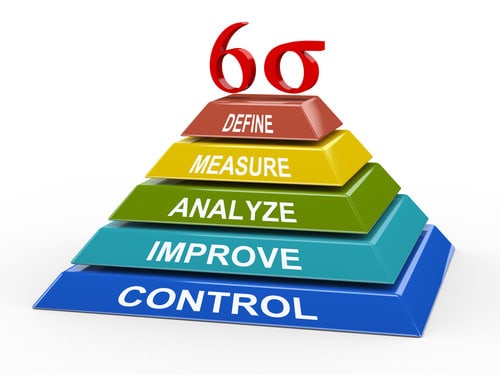Six Sigma
Term Definition of Six Sigma Six Sigma is a disciplined, data-driven approach and methodology for eliminating defects (driving towards six standard deviations between the mean and the nearest specification limit) in any process – from manufacturing to transactional and from product to service. The statistical representation of Six Sigma describes quantitatively how a process is […]
Term Definition of Six Sigma
Six Sigma is a disciplined, data-driven approach and methodology for eliminating defects (driving towards six standard deviations between the mean and the nearest specification limit) in any process – from manufacturing to transactional and from product to service.
The statistical representation of Six Sigma describes quantitatively how a process is performing. To achieve Six Sigma, a process must not produce more than 3.4 defects per million opportunities. A Six Sigma defect is defined as anything outside of customer specifications. A Six Sigma opportunity is then the total quantity of chances for a defect.
 How is Six Sigma implemented?
How is Six Sigma implemented?
There are various frameworks for implementing the Six Sigma methodology. Six Sigma Consultants worldwide have developed proprietary methodologies for implementing Six Sigma quality, based on the similar change management philosophies and application of tools.
The fundamental objective of the Six Sigma methodology is the implementation of a measurement-based strategy that focuses on process improvement and variation reduction through the application of Six Sigma improvement projects. In other words, Six Sigma strives to eliminate defects and improve quality through repeatable measurable processes. This is accomplished through the use of two Six Sigma sub-methodologies: DMAIC and DMADV. The Six Sigma DMAIC process (define, measure, analyze, improve, control) is an improvement system for existing processes falling below specification and looking for incremental improvement. The Six Sigma DMADV process (define, measure, analyze, design, verify) is an improvement system used to develop new processes or products at Six Sigma quality levels. It can also be employed if a current process requires more than just incremental improvement. Both Six Sigma processes are executed by Six Sigma Green Belts and Six Sigma Black Belts, and are overseen by Six Sigma Master Black Belts.
The key concepts of Six Sigma are Critical to Quality (attributes most important to the customer), Defect (failing to deliver what the customer wants), Process Capability (what your process can deliver), Variation (what the customer sees and feels), Stable Operations (ensuring consistent and predictable processes to improve what the customer sees and feels) and Design for Six Sigma (designing to meet customer needs and process capability).
Processes become more capable when they are standardized across the organization and their performance is monitored against historical data. This way you can detect variation in performance early enough to address it less expensively. And ultimately, the process should be continuously improving through identifying the root causes of variability and innovative ways to fulfill its objectives.
This is the beauty of Six Sigma.
